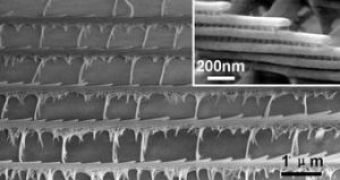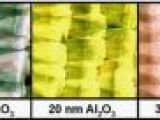You would not have believed that such a fragile structure like a butterfly wing could serve as a mold.
But scientists have managed to achieve complex nanometer-scale photonic structures using as template the structures that help give butterfly wings their color.
The new nanoscale structures could be used as optical waveguides, optical splitters and other building blocks of photonic integrated circuits.
The team at the Georgia Institute of Technology produced aluminum oxide (alumina) replicas of wing scales from a Morpho peleides butterfly, a bright blue species from the rain forests of tropical America, using a low-temperature atomic layer deposition (ALD) process that deposits uniform layers one Angstrom at a time.
"We can never come close to the richness of the structures that nature can make," said Zhong Lin Wang, Regents' Professor in the Georgia Tech School of Materials Science and Engineering.
"We want to utilize biology as a template for making new material and new structures."
To crystallize the alumina (in order to make it stronger), the coated scales were heated to 800 degrees Celsius, burning off the original butterfly wing scale.
The artificial alumina butterfly wing scale retains the features of the original, including hollow tubular structures that split off at regular intervals; they could be used as optical waveguides and optical splitters or as microfluidic or microreactor devices.
"Owing to the excellent uniformity of the alumina film, both the large-scale arrangement of the wing scales and the nanometer-scale periodic structures are perfectly preserved after this vigorous template removal process."
"The alumina replicas of the wing scales exhibit the same shape, orientation, and distribution as their 'parent' scales."
Butterfly wing colors are the result of a mix between pigments and reflection from photonic structures.
The artificial wing scales also reflect blue waves, but the color is of slightly longer wavelength than that of the original butterfly.
"That's because the chemical pigments that contribute to the original butterfly color are no longer present, and because the researchers had to dry the wing scales prior to deposition, which likely altered the size of their photonic structures." said Wang.
As the thickness of the alumina coating determines the size and periodicity of the photonic structures, changing the thickness shifted the reflected light toward the red zone of the spectrum.
"For instance, by increasing the coating thickness from 10 to 40 nanometers, the color reflected by the alumina wing scales shifted from the original blue to green, yellow, orange and eventually pink," said Wang.
"The complex nature of the structures would be impossible to create with any other process," he said.
"It allows us to fabricate truly tubular, three-dimensional interconnected nanostructures in a one-step process."
ALD could also employ other materials such as titanium oxide, and to replicate other biologically-inspired structures.
"As long as there is a void that the vapor phase can penetrate, an entire structure can be replicated using the ALD process," Wang said.
The next pattern scientists want to replicate is that of the micron-scale structures on the feet of the water strider, a bug that uses its unique hydrophobic feet to gracefully skim across the surface of water on lakes and ponds.
Photo credit: Zhong Lin Wang.

 14 DAY TRIAL //
14 DAY TRIAL // 
